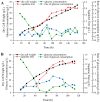Optimization of Squalene Production by Pseudozyma sp. P4-22
- PMID: 40286257
- PMCID: PMC11990619
- DOI: 10.3390/molecules30071646
Optimization of Squalene Production by Pseudozyma sp. P4-22
Abstract
Squalene is an important bioactive substance widely used in the food, pharmaceutical, and cosmetic industries. Microbial production of squalene has gained prominence in recent years due to its sustainability, safety, and environmental friendliness. In this study, a mutant strain, Pseudozyma sp. P4-22, with enhanced squalene-producing ability, was obtained through atmospheric and room temperature plasma mutagenesis of the previously screened squalene-producing yeast Pseudozyma sp. SD301. The P4-22 strain demonstrated the ability to produce squalene using various carbon and nitrogen sources. We optimized the culture conditions by employing cost-effective corn steep liquor as the nitrogen source, and the optimal pH and sea salt concentration of the medium were determined to be 5.5 and 5 g/L, respectively. Under optimal cultivation conditions, the biomass and squalene production reached 64.42 g/L and 2.06 g/L, respectively, in a 5 L fed-batch fermentation. This study highlights the potential of Pseudozyma sp. P4-22 as a promising strain for commercial-scale production of squalene.
Keywords: Pseudozyma sp.; corn steep liquor; culture optimization; fermentation; mutagenesis; squalene.
Conflict of interest statement
The authors declare no conflicts of interest. The funders had no role in the design of the study; in the collection, analyses, or interpretation of data; in the writing of the manuscript; or in the decision to publish the results.
Figures






Similar articles
-
High Production of Squalene Using a Newly Isolated Yeast-like Strain Pseudozyma sp. SD301.J Agric Food Chem. 2015 Sep 30;63(38):8445-51. doi: 10.1021/acs.jafc.5b03539. Epub 2015 Sep 15. J Agric Food Chem. 2015. PMID: 26350291
-
The isolation and characterization of Pseudozyma sp. JCC 207, a novel producer of squalene.Appl Microbiol Biotechnol. 2008 Apr;78(6):963-72. doi: 10.1007/s00253-008-1395-4. Epub 2008 Feb 26. Appl Microbiol Biotechnol. 2008. PMID: 18299826
-
Thraustochytrium sp. and Aurantiochytrium sp.: Sustainable Alternatives for Squalene Production.Mar Drugs. 2025 Mar 19;23(3):132. doi: 10.3390/md23030132. Mar Drugs. 2025. PMID: 40137318 Free PMC article.
-
Optimization of nitrogen source for enhanced production of squalene from thraustochytrid Aurantiochytrium sp.N Biotechnol. 2010 Sep 30;27(4):382-9. doi: 10.1016/j.nbt.2010.04.005. Epub 2010 Apr 20. N Biotechnol. 2010. PMID: 20412873
-
Biotechnological production of value-added compounds by ustilaginomycetous yeasts.Appl Microbiol Biotechnol. 2017 Nov;101(21):7789-7809. doi: 10.1007/s00253-017-8516-x. Epub 2017 Sep 18. Appl Microbiol Biotechnol. 2017. PMID: 28921339 Review.
References
-
- Warleta F., Campos M., Allouche Y., Sánchez-Quesada C., Ruiz-Mora J., Beltrán G., Gaforio J.J. Squalene protects against oxidative DNA damage in MCF10A human mammary epithelial cells but not in MCF7 and MDA-MB-231 human breast cancer cells. Food Chem. Toxicol. 2010;48:1092–1100. doi: 10.1016/j.fct.2010.01.031. - DOI - PubMed
MeSH terms
Substances
Grants and funding
LinkOut - more resources
Full Text Sources

